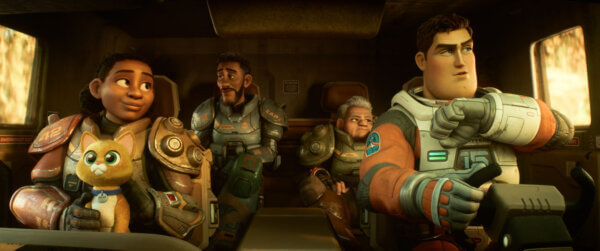Lightyear Review: The Final Frontier For Pixar’s Legacy Characters
The parallels between Lightyear and Top Gun: Maverick should have dawned on me sooner. Aside from both being beautiful looking films about the best damn pilot we have, they go to great lengths to have our characters depicted as relics of a bygone era. The meta commentary of Maverick looks to be a ham-fisted punch in the face of straight-to-streaming cinema, something that looks to prove that the movie-going experience still holds value for our society.
The narrative around Lightyear has not been similar, but I think it should have been. The film is an interesting allegory to what Buzz Lightyear means to a world, an animation industry, and a Pixar that is so different now. The company has fallen off the cutting edge of cinema and lost some cultural cache. Original stories such as Soul and Turning Red have seen them claw into a new era, so what is the use in revisiting Buzz?
Many Pixar films seem to pose a question themselves. What if *blank* had feelings? What if this happens when we die? For Lightyear, I suspect that question was ‘What if our movie was just really f’ing fun?’ Rather than a tale set in the Toy Story universe, we get treated to the 80s sci-fi action film which Andy fell in love with, causing him to want to get that Buzz Lightyear toy. We see Buzz (Chris Evans) mistakenly maroon 1200 Star Command troops on a hostile planet through his hubris and, through that same hubris, try and fail repeatedly to bring the squad home. Relatively unbound to the established canon, Lightyear is free to tell a story of huge scope, spanning space and time.

TEAMING UP – Disney and Pixar’s “Lightyear” is a sci-fi action adventure and the definitive origin story of Buzz Lightyear (voice of Chris Evans), the hero who inspired the toy. The all-new story follows the legendary Space Ranger on an intergalactic adventure alongside a group of ambitious recruits (voices of Keke Palmer, Taika Waititi and Dale Soules), and their robot companion Sox (voice of Peter Sohn). Also joining the cast are Uzo Aduba, James Brolin, Mary McDonald-Lewis, Efren Ramirez and Isiah Whitlock Jr. Directed by Angus MacLane (co-director “Finding Dory”) and produced by Galyn Susman (“Toy Story That Time Forgot”), “Lightyear” releases June 17, 2022. © 2022 Disney/Pixar. All Rights Reserved.
Lightyear moves quickly, and in my experience I was able to follow the plot and character motivations with relative ease, though I won’t blame anyone who gets lost in the mayhem at times. There is also a cynicism to Lightyear which is difficult to ignore. This getting a cinematic release over recent Pixar triumphs such as Soul, and particularly Turning Red, genuinely hurts.
Lightyear had to prove its worth. In order for such an easy cash-grab to exist, it had to do something interesting. It just about gets there. Rarely a scene goes by without some stunning shots, the overall design of the movie is quite singular, going for a chunky, toy-like aesthetic. I also felt like the story and Buzz’s character arc was unique in its maturity compared to the rest of the Pixar canon. Rather than have a teachable lesson for children, Lightyear is about an authority figure coming to terms with his regrets.
Unique was not a word I was expecting to use in this review. Director and writer Angus MacLane has worn his influences on his sleeve with this movie. He mapped his own experience of watching Star Wars as a child onto what he imagined Andy’s experience to be with Lightyear, and a reverence for that franchise is clearly woven into the DNA of this film. However, there are also nods to Lynch’s Dune, Alien, and by extension, Metroid. This is not an attempt to remake Star Wars, but is a heart-warming love letter to the sci-fi genre, using the medium of highly polished animation to elevate it further. One’s mileage will of course vary, but my personal love of sci-fi was reflected on screen.
Originality can be lost within homage, and a lesser studio may have never found it. Pixar’s ability to put a personal, character-focused story in the middle of a world of sentient vines, killer robots and multi-functional felines is such a singular trait. Lightyear is not your typical tear-fest, which may disappoint people with those expectations of Pixar projects. However, the movie does introduce a mature arc into an 80s sci-fi setting, something I found exhilarating.
Though I love the presence of this arc, Buzz’s need to go from individualist to trusting his teammates is rather heavy handed. The plot’s want is to twist and jump from set-piece to set-piece, meaning character work can’t always be integrated into the plot so smoothly. The set-pieces all worked for me, meaning I was just about able to overlook this. The Disney trope of having a pure shock value twist villain is dangerously close to having an unwelcome appearance here, but the movie is thankfully smarter than that. Though heavy handed, the villain of Lightyear is purposefully designed.

EVIL EMPEROR – Disney and Pixar’s “Lightyear” is a sci-fi action adventure and the definitive origin story of Buzz Lightyear (voice of Chris Evans), the hero who inspired the toy. The story, which follows the legendary Space Ranger on an intergalactic adventure, features none other than Zurg—a seemingly invincible adversary of Buzz who would go on to inspire his own toy. Featuring the voices of Uzo Aduba, James Brolin, Mary McDonald-Lewis, Keke Palmer, Efren Ramirez, Peter Sohn, Dale Soules, Taika Waititi and Isiah Whitlock Jr., “Lightyear” releases June 17, 2022. © 2022 Disney/Pixar. All Rights Reserved.
Where Lightyear and Top Gun: Maverick differ is in their relationships to their own legacies. Maverick exists fully in service of its legacy while Lightyear wants to simultaneously profit off it and cut itself loose from it. In a wider sense I see this as Pixar releasing themselves from the weight of their own expectations. The world almost moved beyond Pixar, leaving it a relic of a decades-old era, much like Buzz in this movie.
In a strange way, Lightyear is Pixar moving past themselves. Exorcised of the need to squeeze tears from the audience, but also in a position where they need to pay off a character’s legacy, this is Pixar caught between generations. They do not employ the new, more cartoony art style of Luca and Turning Red, instead they design a movie around their signature, once groundbreaking style while telling a story in a way they haven’t really done before. This is a transition between eras.
Lightyear probably won’t make you cry, there is no love interest, no mediation on the nature of existence. Lightyear is Pixar’s first thrill-ride, an 80s-style ‘one last job’ for their most fundamental icon.
Lightyear is in cinemas now.

